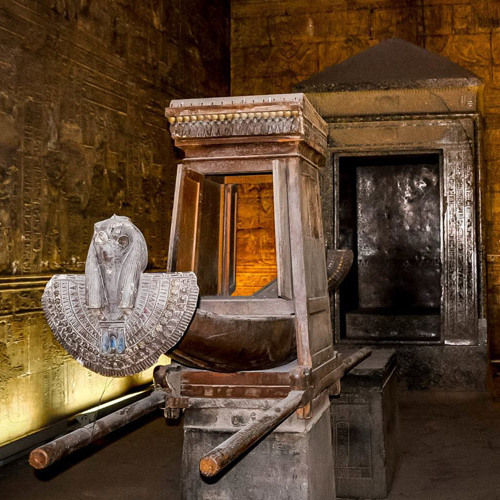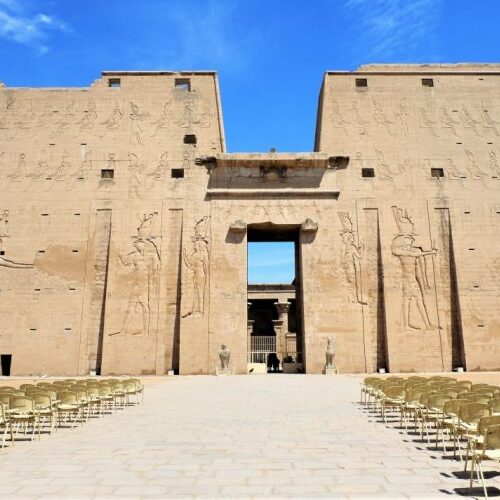No other nation in the world says ‘Welcome’ as often as the Egyptians, and every time, they mean it. While the ancient civilization of Egypt continues to amaze, contemporary Egyptians are equally remarkable.
Edfu Historical Guide
Unveiling the Enigma of Edfu: A Journey Through Time and Majesty
In the heart of Egypt, where the timeless sands whisper tales of centuries past, the Temple of Horus at Edfu emerges as a luminous jewel among the remnants of antiquity. Among the countless temples scattered throughout this ancient land, Edfu’s grandeur remains unrivaled, for it stands as the only temple known to have been completed in its entirety. Crafted meticulously from the resplendent sandstone blocks, this colossal Ptolemaic temple is a testament to human ingenuity and devotion.
As one ventures closer, the temple’s distinctive transformation becomes apparent. It was built upon the hallowed grounds of an earlier temple, a structure that faced the river with its majestic gaze. However, the later temple, with its magnificent orientation from north to south, now obscures the remnants of its predecessor’s eastern pylon, a silent witness to the passage of epochs. Though the veil of time shrouds the earliest temple of Horus in Edfu in mystery, inscriptions bearing the names of New Kingdom rulers, including Seti I, Rameses II, and Rameses III, hint at their contributions to its legacy.
The genesis of the current temple, which we stand before today, can be traced back to 237 BC when Ptolemy III Euergetes I laid its foundations. Yet, this monumental masterpiece was not unveiled in its entirety until 57 BC. Visitors of yore approached this sacred sanctuary by passing the imposing western enclosure wall, adorned with exquisite carvings depicting the Ptolemaic kings paying homage to various deities.
Today, a newly constructed coach park, a welcoming cafeteria, and an open-air museum guide visitors seamlessly to the temple’s entrance. As one arrives at the temple’s threshold, the first architectural wonder to greet them is the rectangular colonnaded building known as a “Mammisi,” a Graeco-Roman birth-house. This structure, dedicated to celebrating the divine birth of Horus, served as the inspiration for the Roman Mammisi at Dendera. Adorned with intricate reliefs depicting the god Bes, birth scenes, and the nurturing embrace of Hathor upon the infant Horus, this structure offers a captivating glimpse into ancient beliefs.
Stepping closer, the colossal twin towers of the temple’s entrance pylon loom overhead, each a mirror image of the other. They bear witness to timeless scenes of the king vanquishing his foes before the watchful eye of Horus. Mast grooves, where flags once fluttered in the breeze, remain etched into the stone, preserving a piece of the temple’s history. Standing guard at the gateway, two statues of Horus falcons stand sentinel, their unwavering presence echoing the temple’s enduring sanctity.
Crossing the threshold, visitors are greeted by a paved courtyard flanked by colonnades adorned with reliefs depicting the “Feast of the Beautiful Meeting,” a grand festival celebrating the annual reunion of Hathor and Horus. The walls of the courtyard narrate the tale of this magnificent celebration.
Ahead lies the main temple façade, presided over by the iconic colossal black granite statue of Horus, bedecked in the regal double crown of Upper and Lower Egypt. Screen walls adorned with engaged columns, the hallmark of Late Period and Ptolemaic temples, flank the entrance.
Stepping inside, one is enveloped by the mesmerizing symphony of birdsong emanating from the roof above. This outer hypostyle hall, or pronaos, boasts 18 towering columns that support a celestial ceiling adorned with astronomical figures. The walls come alive with scenes of offerings and well-preserved reliefs recounting the temple’s foundation ceremony. A pair of small chambers adorns the south wall: the “House of the Morning” on the west and the “House of Books” on the east.
The inner sanctum of the Edfu temple, akin to Dendera, reveals its sacred secrets. The second hypostyle hall, known as the naos or Great Court, predates the pronaos and boasts 12 slender columns that gracefully support its ceiling. These hallowed halls conceal chambers dedicated to offerings, a laboratory housing recipes for incense and ointments, and a treasury safeguarding gold, silver, precious stones, amulets, and ritual implements.
Beyond the Great Court lies a transverse hall leading to staircases that ascend to the temple’s roof, offering awe-inspiring views of the temple complex. The walls of these staircases bear intricate carvings of priests in procession, bearing sacred implements and standards.
A stone’s throw away lies an open-air offering court, home to a kiosk-like shrine known as “The Pure Place.” Echoes of this shrine resonate at Dendera Temple, with its celestial ceiling depicting the sky-goddess Nut.
Journeying further, we arrive at the holiest of holies, the sanctuary. Here, the temple’s most sacred relics find their dwelling, including the ancient granite naos shrine adorned with cartouches of Nectanebo II from Dynasty XXX. Nearby, a chapel cradles a reproduction of the barque of Horus, a poignant reminder of the temple’s enduring devotion.
Chambers dedicated to various gods and the temple’s daily rituals surround the sanctuary, some concealing crypts, their secrets hidden from the prying eyes of visitors. An ambulatory corridor encircles the inner temple, bearing texts that recount the temple’s founding and building, as well as scenes from the “Triumph of Horus,” a mythical narrative that played out each year as a mystery play.
On the northern enclosure wall, a mesmerizing set of reliefs unveils the “Installation of the Sacred Falcon,” a pivotal ritual that crowned a live falcon as the embodiment of both Horus and the reigning king. This sacred ceremony, etched into stone, resonates with the temple’s spiritual significance.
Throughout the ages, dedicated scholars and Egyptologists have tirelessly sought to unlock the mysteries of Edfu temple. Recent ground-breaking studies have shed light on the intricate hieroglyphic texts, breathing life into ancient Egyptian religion and mythology. The Ptolemaic carvings that have slumbered in stone for millennia have become a vast and invaluable source of knowledge, a bridge spanning time and revealing the hidden tapestry of temple rituals and Egyptian history.
As we stand within the hallowed precincts of Edfu, we are not merely spectators of history; we become part of its enduring narrative. The Temple of Horus at Edfu stands as a beacon of Egypt’s resplendent past, a testament to the unwavering spirit of a civilization that has transcended time itself. It beckons us to explore, to marvel, and to connect with the mysteries that lie hidden within its sacred walls, inviting us to embark on an unforgettable journey through the sands of time.
Created On March 18, 2020
Updated On Aug , 2024



